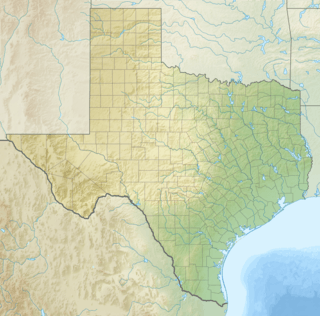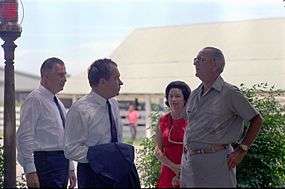Lyndon B. Johnson National Historical Park
| Lyndon B. Johnson National Historical Park | |
|---|---|
|
IUCN category V (protected landscape/seascape) | |
|
President Johnson's birthplace in Gillespie County | |
  | |
| Location | Blanco County, Texas and Gillespie County, Texas, USA |
| Nearest city | Johnson City, Texas; Stonewall, Texas |
| Coordinates | 30°14′27″N 98°37′27″W / 30.24083°N 98.62417°WCoordinates: 30°14′27″N 98°37′27″W / 30.24083°N 98.62417°W |
| Area | 1,570 acres (6.4 km2) |
| Established | December 2, 1969 |
| Visitors | 110,791 (in 2012)[1] |
| Governing body | National Park Service, Texas Parks and Wildlife Department |
| Website | Lyndon B. Johnson National Historical Park |

Lyndon B. Johnson National Historical Park is a United States National Historical Park in central Texas about 50 miles west of Austin in the Texas Hill Country.[2] The park protects the birthplace, home, ranch, and final resting place of Lyndon B. Johnson, 36th President of the United States.[3] During Johnson's administration, the LBJ Ranch was known as the "Texas White House" because the President spent approximately twenty percent of his time in office there.[4]
The park is split into two distinct visitor areas: Johnson City District and the LBJ Ranch District. The Johnson City District, located in Johnson City, contains the boyhood home of President Johnson and his grandparents' log cabin settlement, as well as the National Park Visitor Center. The LBJ Ranch District is located roughly 14 miles west of Johnson City along the north side of the Pedernales River. Among the sites preserved at the Ranch are the President's first school, birthplace, Texas White House and the Johnson Family Cemetery, where both President and Lady Bird Johnson are buried.[5] The land south of the Pedernales River is operated as Lyndon B. Johnson State Park and Historic Site. To see the LBJ Ranch, visitors take a self-guided auto driving tour from State Park visitor center; a permit is required.[6]
The park was authorized on December 2, 1969, as Lyndon B. Johnson National Historic Site and was redesignated as a National Historical Park on December 28, 1980.[7][8] Present holdings are approximately 1,570 acres (6.4 km2), 674 acres (2.7 km2) of which are federal. The Johnson family continues to donate land to this property; their most recent gift was in April 1995.[9]
Gallery
 LBJ State Park and Historic Area is separated by the Pedernales River from the Lyndon B. Johnson National Historical Park.
LBJ State Park and Historic Area is separated by the Pedernales River from the Lyndon B. Johnson National Historical Park.- LBJ State Park and Historic Area is separated by the Pedernales River from the Lyndon B. Johnson National Historical Park.
- Sign at entrance to Johnson National Historical Park
- Rear view of President Johnson birthplace
- Young Johnson briefly attended this former one-room school c. 1914.
- Outhouse at Johnson birthplace
- Cattle in the park are descended from former livestock of President Johnson.
- Farmhouse of Samuel Ealy Johnson, Sr., the grandfather of President Johnson; he died when Lyndon was six years of age.
- Though he was affiliated with the Disciples of Christ denomination, President Johnson often worshipped while at his ranch at the Trinity Lutheran Church (shown in the background).
- Air Force One used to bring Lyndon Johnson to the Texas White House
- Chuckwagon at LBJ Ranch used for preparing barbecues.
- Large live oak tree in front of entrance to LBJ Ranch
- The pool at the LBJ Ranch was installed in 1955 after then Senator Johnson's heart attack. He was supposed to use it for exercise, but Mrs. Johnson spent far more time in the water.
- Guests at the LBJ Ranch were sometimes invited to place their names in cement for posterity; here one can see the names of Orville Freeman, Curtis LeMay, and singer Eddy Arnold.
- United States Secret Service agents guarding President Johnson lived in this small house while on duty at the LBJ Ranch.
- The graves of Lady Bird and Lyndon Johnson (his with flag) at family cemetery in the national historical park; the public is not allowed entry into the cemetery.
References
- ↑ "National Park Service Visitor Use Statistics". National Park Service. Retrieved August 5, 2013.
- ↑ Gamino, Denice. "Piece of flying history lands on LBJ Ranch". Austin American Statesman. Retrieved 1 August 2013.
- ↑ "Lyndon B. Johnson State Park & Historic Site". Retrieved 1 August 2013.
- ↑ "The White House Years". Retrieved 1 August 2013.
- ↑ "President Lyndon B. Johnson's Biography". Retrieved 1 August 2013.
- ↑ "State and National Parks in the Highland Lakes Region of Central Texas". Retrieved 1 August 2013.
- ↑ "Lyndon B. Johnson National Historic Site, Texas Establishment - P.L. 91-134" (PDF). 83 Stat. 274-2. U.S. Government Printing Office. Retrieved December 7, 2013.
- ↑ Peters, Gerhard; Woolley, John T. "Richard Nixon: "Statement on Signing Bills for the Preservation of Presidential Birthplaces and Homes.," December 2, 1969". The American Presidency Project. University of California - Santa Barbara. Retrieved December 7, 2013.
- ↑ "Lyndon B. Johnson National Historical Park". Retrieved 1 August 2013.
External links
| Wikimedia Commons has media related to Lyndon B. Johnson National Historical Park. |
-
 Lyndon B. Johnson National Historical Park travel guide from Wikivoyage
Lyndon B. Johnson National Historical Park travel guide from Wikivoyage - Lyndon B. Johnson National Historical Park official site
- Secondary National Park Service site on Johnson National Historic Site
- Lyndon B. Johnson National Historical Park from the Handbook of Texas Online
- "Life Portrait of Lyndon B. Johnson", from C-SPAN's American Presidents: Life Portraits, broadcast from the LBJ Ranch, November 12, 1999



